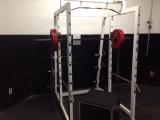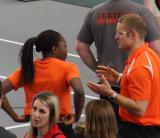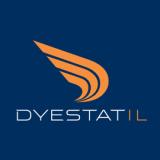Folders |
Throwing Between The Lines: Programming a Peak - April 4, 2013
Published by
By Ben Bishop
When we talk about training the central nervous system (CNS), its worth picturing what exactly the CNS can do. The CNS is what makes our mechanics fire with speed, power, and precision. An example of CNS response: an athlete does 8 max effort single-reps of the clean and jerk and hits a new PR on Monday. On Tuesday, the athlete comes back to train, excited about the PR, not feeling the slightest bit sore, but cannot proficiently perform technical movements as well as he/she should be able to.
This is because the CNS was stressed the day before and the athlete is now feeling that “toasted” feeling from the full body, max effort strength movement performed the day before. If the athlete were continually placed under consecutive days of high CNS stress, injury risk is likely to increase along with performance decline. As a coach, it’s worth planning days of intensive CNS training as well as days of CNS recovery. Also, begin to recognize on an individual basis when your athletes may be having a “flat” day from a previous CNS stressor.
We intensively load the CNS on Monday and Thursday only, with the majority of our practices focused on technical training. An example of a typical training week for us at this point in the season (subject to modification due to meets, of course) looks like:
Monday (Intensive Day): -Moderate volume of throws/drills in both events -Heavy Lifting
Tuesday (Moderately Intensive Day of Training) -Moderate volume of throws/drills in both events -Medball Throws -Core/Accessory training
Wednesday (Light Day) -Video Session -Foam Roll - Light Drills/Throws -Mobility work/stretching
Thursday (Intensive Day) -Moderate volume of throws/drills in both events -“Explosive” lifting
Friday (Light Day) -Varying amount of Throws/Drills -Light Core/Accessory Training
Saturday (Competition) Training/Stimulating the CNS: This lifting approach is similar to that of West Side Barbell and is used by many collegiate strength & conditioning programs across the country (thanks, Coach Block). We implement a heavy training day on Monday, a lighter, more explosive day on Thursday, intertwined with accessory movements during the week, i.e., movements that train the abdominals, low-back, hamstrings, and other muscle groups that are necessary to perform athletic movements efficiently. If you have the means, explosive lifting cycles with bands and chains have also been shown to have a positive affect on power output in athletes. Research has shown that maximum power is best trained when an athlete is able to move 50-70% of their max effort weight as quickly as possible. As strength athletes, developing and increasing power output as well as promoting positive CNS adaptations has useful implications.
Strength Movements: There are plenty of variations to these movements which can be implemented. For young, inexperienced athletes, think about how you could begin to teach the right mechanics in each of these lifts and/or simplify these movements, i.e., lighter weight, dumbbells as opposed to barbells, limiting depth/height, etc. -Squat -Dead-Lift -Bench Press -Overhead Press -Power Cleans/High-Pulls -Jerks -Snatch (Risk/reward of this lift not worth it in most cases) -Step-Ups (weighted) -Box Jumps
Specific Strength Movements: We train med-ball throws the day after the heavy CNS day because it allows us to continue to develop technical mechanics and special strength without requiring the precision of an actual throw. We reinforce correct positions, i.e., being able to use the hips to throw implements, “loose” arms, and the creation of a long push/pull on the implement.
*Heavy Power Throws (Shot Put), Boys- 14 lbs., Girls- 10 lbs. Med-ball Throws: Overhead (for distance) Underhand (for distance) Squat Jumps (for height and/or distance) Two handed “Shot Put” throws (for distance) Core Rotation (two hands, arms extended) throws (for distance) Overhead Right/Left Slams (into the ground, don’t hit yourself in the face!)
Peaking Scheme: The reps/set scheme we are operating within for this week is as follows. (Each number represents the number of reps in a given set.) Monday: 5,4,4,4 (For movements like squat, bench, deads) and 3,3,2,2,1 (for Olympics) Tuesday: Medball throws: 8 throws each movement, max effort, full recovery Thursday: 3,3,3,3,3,3 (scheme for all movements on explosive day) The reps/set peaking system follows a pyramid-like scheme (Ex.: Week 1: 9,9,9. Week 2: 8,8,8. Week 3: 7,7,7, and so on.) that climaxes approximately 10 days before the competition peak (90-95% max, 2,1,1,1). The explosive, power peak will come approximately 7 days before competition peak (~60% max, 2-2-2-2). We implement some submaximal explosive lifting 2-3 days out of the competition peak in hopes of stimulating a positive response from the CNS as opposed to not lifting altogether and being taken out of the rhythm and routine the body has come to anticipate.
Final notes: -Consider the timing of a deload week or recovery week for your athletes and what this could do for their performance and well-being moving forward. In the same logic that we only get stronger while we are resting, a well-programmed deload week lets an athlete’s body/CNS recover and return better.
-If you are not well versed in the Olympic Lifts, don’t feel obligated to implement them. A sloppy power clean isn’t going to make or break your training program, and you can obtain value elsewhere in terms of powerful hip extension (kettlebells, anyone?). Also, although the number of sets may vary, I keep the reps of Olympic Lifts to 3 or less. Any more than this and you’re not really stressing the CNS towards our goal of training maximal power. For the same reason, I keep the explosive lifting, which may consist of movements like squat or bench press, to 4 reps or less.
3 comment(s)
|








